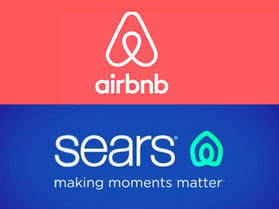Brands are always trying to increase their awareness and change the way people think about them. And, regardless of industry, the reasons for doing so are all over the map.
In most cases, companies want to reshape their current brand proactively. These efforts involve last-ditch attempts to sway public opinion amidst declining sales, as seen in Sears’ rebranding, which resulted in mixed reactions, with some noticing its new logo looked suspiciously similar to Airbnb’s. Some brands may have a stellar narrative, but are struggling to communicate it or haven’t yet built a solid reputation as experts in the industry.
In other scenarios, brands are essentially forced into action, as negative public perception dictates an urgent need for change. Take, for instance, Volkswagen's logo revamp to reference the “electric future” of the company -- an apparent attempt to dissociate itself from the 2015 emissions scandal. In Facebook’s rebranding to FACEBOOK, the company sent clear signals that it is looking to move on from its data privacy scandals and make an effort to re-establish consumer trust.
The point is, whether you’re revamping your brand or building awareness, your project can be motivated by many different things and achieved by many different strategies. Despite all those variables, the same crucial groundwork is necessary for any campaign. These first steps will help you plan effectively and ensure your efforts are built on a rock-solid foundation.
Build a solid footprint
Awareness campaigns can be invigorating because it’s exciting to think about where your brand will be with a few key changes. However, it’s equally important to know exactly where your brand stands before any changes are made.
First, you’ll need to ask some challenging questions about your brand.
- Are you leading the industry?
- Are you lagging behind the industry?
- Are you aligned with where your industry is headed?
The answers to these questions can come from a lot of different places. Competitive analysis will help you understand what industry leaders and growing companies are embracing. Case studies will help you pinpoint best practices and potential missteps. Trends in investing and stock prices will help publicly traded companies identify key areas of Wall Street interest. All of these things can help determine if your brand needs a shift – and what that shift should be.
Ultimately, when your customers interact with your brand, they should have a cohesive experience across all channels. Not only does this mean a consistent look and feel, but your brand’s story should clearly demonstrate your key value propositions and differentiators in the market. Setting this foundation is vital to a successful campaign.
Set clear goals through benchmarking
Many organizations state a desire to “move the needle” with a branding campaign. With that in mind, you can’t tell if the needle has moved – and how far – without extensive knowledge of your existing brand.
Deep insights into your current demographics, audience personas and customer preferences provide benchmarks that will help you measure post-campaign success.
Unfortunately, many people aren’t wild about change. With that in mind, you must consider the possibility that a rebranding campaign may reach new audience segments at the expense of alienating some of your existing customers. When it comes to messaging and other vital elements of your rebranding campaign, you shouldn’t just wing it. To ensure those elements resonate with target audiences, you’ll need to engage in message testing with your target market.
Executing targeted and strategic activations
Truly shifting your brand is not for the faint of heart. It’s a highly strategic business decision, not just a “makeover.” There are plenty of costs -- and risks -- involved. There’s also a lot of work that needs to be done after the foundation building and benchmarking is complete.
Once you’ve done the all-important legwork, the stage is set for you to introduce and competitively position your brand to your customers, employees, investors and others in the industry.
To do this effectively, you’ll need targeted activation strategies, often falling under the categories of owned, earned and shared, to reach these various audiences. Media relations, social media and digital marketing work together to provide third-party validation and build thought leadership profiles of your executives, as well as attracting and retaining talent.
Know when to ask for help
Building your brand involves a lot of moving parts: from the initial foundation-building to benchmarking against your goals and ensuring you have the proper activation strategies in place. To help determine if you’re on the right track, download the “Brand Awareness: The Ultimate Marketing Checklist” today.
This blog post is adapted from Lisa Vallee-Smith's original LinkedIn article.







